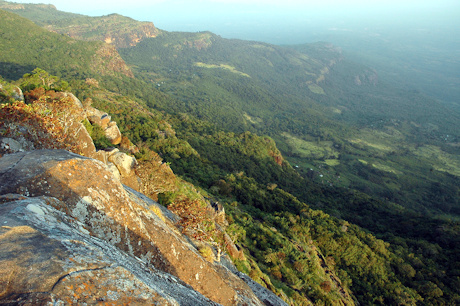Take a trip to the west coast of Africa to a small country of coastal plains, rugged highlands, humid rainforests and dry deserts. Guinea could be one of Africa’s richest nations thanks to its wealth of minerals, but most people remain poor after decades of unstable government. Scroll down below to test your knowledge with our range of printable resources.

View from Mt Loura of the Fouta Djallon mountains in central Guinea
A Little Geography…
- Guinea is found on the Atlantic coast and borders Liberia, Sierra Leone, Guinea-Bissau, Senegal, Mali and Ivory Coast. The capital is Conakry.
- The country covers an area of about 245,000 square kilometres – of which nearly 30 per cent is tropical forest. The highest peak is Mount Nimba at 1,752 metres.
- French is the official language, but with 24 ethnic groups many tribal dialects are also spoken. The country has a population of around 12 million people, who are mostly Muslim.
- Around two-thirds live in rural areas, growing enough to feed their families, but the country’s wealth depends on mining. Guinea is the world’s second-largest producer of bauxite (used to make aluminium) and is rich in gold and diamonds. Coffee and fish are also important exports.
A Little History…
- Guinea gets its name from the Guinea region, which was home to West African empires such as the Mali, Ghana Empire and Songhai Empire.
- During European colonisation, the Portuguese were the first to arrive and then France took control in 1898, claiming their portion as ‘French Guinea’.
- In 1958, the country gained independence from France but decades of unstable rule have followed. Hundreds of thousands of refugees from Liberia and Sierra Leone have also added to the country’s difficulties.
- In 2014, an outbreak of the deadly Ebola virus in southern Guinea saw the disease spread to Liberia and Sierra Leone. Over 11,000 people died in just two years.
And Some Interesting Facts…
- Guinea is sometimes called Guinea-Conakry to distinguish it from other ‘Guinea’ countries in the region such as Guinea-Bissau and Equatorial Guinea.
- West Africa’s three largest rivers start in the highlands of Guinea – the Niger, the Gambia and the Senegal.
- Guinea’s flag features three vertical stripes of red, yellow and green. Red for the struggle for independence, yellow for the sun and the land’s riches, and green for the country’s vegetation. The colours from left to right are the reverse of the flag for Mali.
- Football is a popular sport in Guinea. The national football team is nicknamed Syli Nationale (which translates as ‘National Elephants’).
The Guinea Flag

The Guinea flag features three vertical bands of red, yellow and green. Red stands for the struggle for independence, yellow symbolises the sun, and the green represents the country's vegetation. The flag was officially adopted on November 10, 1958.
Our Guinea Resources
African flags often use the colours red, green and yellow, and the Guinea flag is no exception. The stripes are red, yellow and green, from left to right.
We have four different sizes of the Guinea flag available for you to print out and use in displays, crafts and school projects.
Find Guinea on this outline map of Africa - do you know the name and location of the capital city too?
We've marked Guinea in red on this map, so you can spot it easily!
Here's a simple fact-finding worksheet all about Guinea, perfect for your geography studies...

